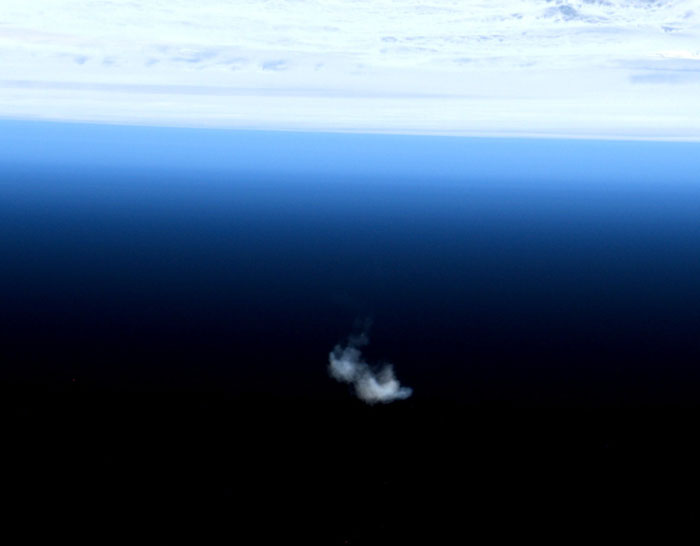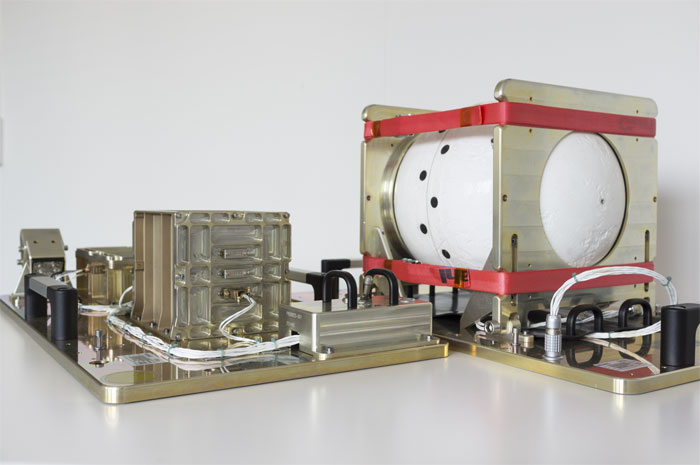.

ATV’s re-entry as seen from the space station. Credit: ESA/NASA
-
A camera packed inside Europe’s Automated Transfer Vehicle failed to transmit images from inside the disposable supply ship as it plunged through Earth’s atmosphere Feb. 15 and broke apart over the South Pacific Ocean, the European Space Agency said Friday.
The robotic cargo freighter carried a camera and instrument package cocooned inside a miniature heat shield to survive the temperatures and pressures of re-entry. While telemetry indicated the camera took nearly 6,000 pictures, none of the images were received by engineers.
ESA said the information still will help scientists study re-entry dynamics and could contribute to the design of future spacecraft to minimize the risks of space junk, but the loss of imagery from the ATV’s destructive dive back to Earth left officials with a small fraction of the data originally slated for collection during the European cargo craft’s re-entry.
The ATV’s final mission was the last chance in the foreseeable future to monitor the guided, destructive re-entry of such a large spacecraft.
The ATV was the size of a double-decker bus and capable of lofting a mix of experiments, crew supplies, spare parts, water, air and propellant to the International Space Station. At the end of the ATV’s fifth flight, the craft undocked from the space station Feb. 14 and steered toward a fiery fall into Earth’s atmosphere one day later.
Engineers wanted to use the opportunity to record data that could help mission planners prepare for the eventual re-entry of the International Space Station — the largest complex ever assembled in space — some time in the 2020s.
Scientists worked for more than a year to plan a modified re-entry profile for the fifth and final ATV that called for the spacecraft to dive into the atmosphere at a shallower-than-usual angle, exposing it to different conditions than previous re-entries before breaking apart dozens of miles above the uninhabited South Pacific.
The re-entry would be perfectly timed for a NASA DC-8 research airplane to watch it from below, and for astronauts on the space station to record imagery of the ATV’s destruction from above.
Two data recorders supplied by NASA and ESA would ride inside the ATV’s pressurized cargo section, logging temperatures, pressures, loads, g-forces and other parameters.
But a battery failure in one of the freighter’s four power chains cropped up in early February, and although the glitch did not affect the ATV in a normal operating mode, ESA officials decided to forgo the shallow entry and aim for a standard steep profile used on previous missions.
NASA opted to remove its re-entry data recorder and keep it aboard the space station for use on a future spacecraft, but ESA kept its system inside the ATV.
The infrared camera and communications package, made by Ruag Space in Switzerland, was supposed to take a series of pictures and transmit the imagery to scientists via Iridium satellites.
The camera itself was not designed to survive re-entry, but the communications transmitter was encased in a spherical ceramic heat shield to withstand the high temperatures, then send the camera’s imagery before impacting the ocean.
ESA said in a press release that the break-up camera’s ground team received one message from the communications package. Later messages expected to contain the images never arrived.
.

The ATV’s re-entry breakup camera and transmitter. Credit: Ruag Space
.
“The message we received contained information on the number of pictures taken — nearly 6,000 — as well as accelerometer and magnetometer readings, details of the sphere rotation and a temperature reading,” said Neil Murray, manager of ESA’s break-up camera team.
Murray said the message confirmed all systems initially worked as intended, including the camera, software, and the communications system’s modem and heat shield.
“We also know from the message the internal temperature of the sphere remained moderate and there were no signs of any thermal issues,” Murray said in an ESA press release.
“To retrieve all the data, more messages would have been required, but — frustratingly — these have nor arrived. Our team is currently investigating why further data packets didn’t make it through,” Murray said. “This investigation may result in improvements, such as a backup data relay for future missions.”
The ATV’s five missions sent up 31,446 kilograms, or 69,327 pounds, of cargo, fuel, water and air to the space station. They five flights spent a cumulative 776 days docked to the space station on missions launched in 2008, 2011, 2012, 2013 and 2014.
ESA wished to stop producing ATVs after the fifth model, preferring to focus European industry on the development of a new project using technologies from the cargo resupply program.
The five ATV flights were part of a barter agreement with NASA to pay Europe’s share of the space station’s operating costs through 2017.
ESA and Airbus Defense and Space, the ATV’s prime contractor, are now working on a propulsion and power module for NASA’s Orion crew capsule. It will fly on the Orion spacecraft’s next test flight around the moon and back to Earth in 2018.
The Orion service module contribution covers ESA’s cost commitment to the space station through 2020.
Quelle: SN
4138 Views
